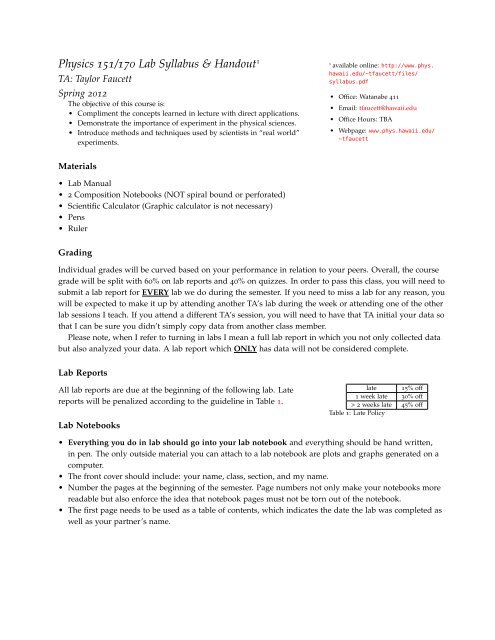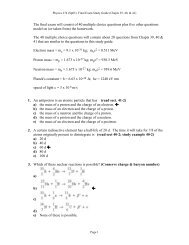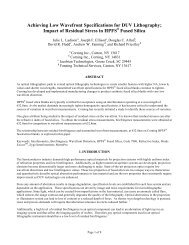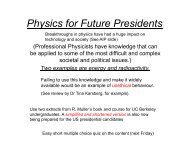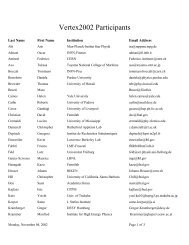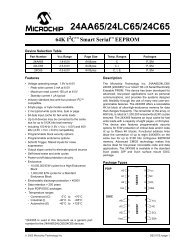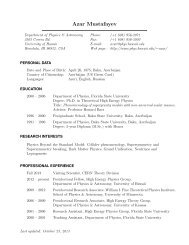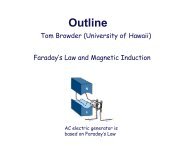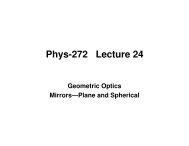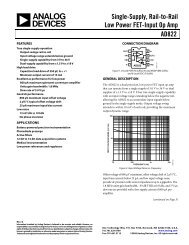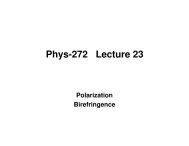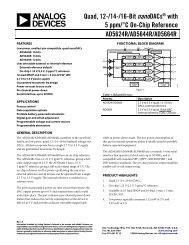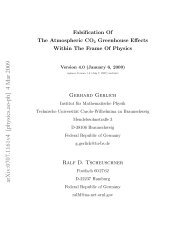PHYS 151/170 (.pdf) - University of Hawaii
PHYS 151/170 (.pdf) - University of Hawaii
PHYS 151/170 (.pdf) - University of Hawaii
Create successful ePaper yourself
Turn your PDF publications into a flip-book with our unique Google optimized e-Paper software.
Physics <strong>151</strong>/<strong>170</strong> Lab Syllabus & Handout 1<br />
TA: Taylor Faucett<br />
1<br />
available online: http://www.phys.<br />
hawaii.edu/~tfaucett/files/<br />
syllabus.<strong>pdf</strong><br />
Spring 2012 • Office: Watanabe 411<br />
The objective <strong>of</strong> this course is:<br />
• Compliment the concepts learned in lecture with direct applications.<br />
• Demonstrate the importance <strong>of</strong> experiment in the physical sciences.<br />
• Introduce methods and techniques used by scientists in “real world”<br />
experiments.<br />
• Email: tfaucett@hawaii.edu<br />
• Office Hours: TBA<br />
• Webpage: www.phys.hawaii.edu/<br />
~tfaucett<br />
Materials<br />
• Lab Manual<br />
• 2 Composition Notebooks (NOT spiral bound or perforated)<br />
• Scientific Calculator (Graphic calculator is not necessary)<br />
• Pens<br />
• Ruler<br />
Grading<br />
Individual grades will be curved based on your performance in relation to your peers. Overall, the course<br />
grade will be split with 60% on lab reports and 40% on quizzes. In order to pass this class, you will need to<br />
submit a lab report for EVERY lab we do during the semester. If you need to miss a lab for any reason, you<br />
will be expected to make it up by attending another TA’s lab during the week or attending one <strong>of</strong> the other<br />
lab sessions I teach. If you attend a different TA’s session, you will need to have that TA initial your data so<br />
that I can be sure you didn’t simply copy data from another class member.<br />
Please note, when I refer to turning in labs I mean a full lab report in which you not only collected data<br />
but also analyzed your data. A lab report which ONLY has data will not be considered complete.<br />
Lab Reports<br />
All lab reports are due at the beginning <strong>of</strong> the following lab. Late<br />
reports will be penalized according to the guideline in Table 1.<br />
Lab Notebooks<br />
late 15% <strong>of</strong>f<br />
1 week late 30% <strong>of</strong>f<br />
> 2 weeks late 45% <strong>of</strong>f<br />
Table 1: Late Policy<br />
• Everything you do in lab should go into your lab notebook and everything should be hand written,<br />
in pen. The only outside material you can attach to a lab notebook are plots and graphs generated on a<br />
computer.<br />
• The front cover should include: your name, class, section, and my name.<br />
• Number the pages at the beginning <strong>of</strong> the semester. Page numbers not only make your notebooks more<br />
readable but also enforce the idea that notebook pages must not be torn out <strong>of</strong> the notebook.<br />
• The first page needs to be used as a table <strong>of</strong> contents, which indicates the date the lab was completed as<br />
well as your partner’s name.
physics <strong>151</strong>/<strong>170</strong> lab syllabus & handout 2<br />
Academic Honesty<br />
The <strong>University</strong> <strong>of</strong> <strong>Hawaii</strong> does not tolerate cheating and severe penalties will be imposed for any instance<br />
<strong>of</strong> dishonesty. Collaborating on quizzes, copying written work and falsifying data are all examples <strong>of</strong> academic<br />
dishonesty. A complete overview <strong>of</strong> the <strong>University</strong> policy is available in the Student Code <strong>of</strong> Conduct.<br />
Please note, there is a fine line between “writing things down the same way as your lab partner” and<br />
outright cheating. If I’m ever in doubt as to whether or not your writing is your own work or in your own<br />
words, I’ll automatically assume it’s cheating and you’ll get a zero on that assignment. If it happens multiple<br />
times, you should expect to fail the class.<br />
Expectations and Grading<br />
Lab Schedule<br />
Quizzes will be given at the beginning <strong>of</strong> each class and you won’t be able to make up a quiz if you are<br />
late or miss a lab. For this reason, it is in your best interest to arrive on time. We will be alternating between<br />
two rooms (PSB 108 and PSB 110) and the room we will be in will be determined by the classes<br />
group number (make sure you know it). See Table 2, or page xi in your lab manual for the schedule.<br />
Lab Group I. Group II.<br />
Introduction (108) (110)<br />
Vectors/Statistics (108) (110)<br />
Errors (108) (110)<br />
Darts (110) (108)<br />
Pendulum (108) (110)<br />
Air Track (110) (108)<br />
Energy Transfer (110) (108)<br />
Kinetic and Potential (108) (110)<br />
Rotational Motion (108) (110)<br />
Natural Oscillations (110) (108)<br />
Driven Oscillations (108) (110)<br />
Liquid Drag (110) (108)<br />
Spring <strong>of</strong> Air (108) (110)<br />
Table 2: Mechanics Lab Schedule<br />
You WILL lose points for...<br />
In previous courses I’ve been asked to make my grading criteria more descriptive. Below, I’ve detailed<br />
some <strong>of</strong> the specific things you should avoid doing as a part <strong>of</strong> your lab notebook.<br />
Missing Important Information: Part <strong>of</strong> your job as a budding experimental physicist is to determine what<br />
information is relevant and which section <strong>of</strong> your lab notebook it should go into (i.e. Data, Error Analysis,<br />
Calculations).<br />
Incorrect Information: Everyone that takes this class struggles with the concept <strong>of</strong> error analysis. If you cite,<br />
for example, “Human Error” in your Error Analysis section, you will lose points.
physics <strong>151</strong>/<strong>170</strong> lab syllabus & handout 3<br />
Missing Units/Incorrect Units: Anytime you do a calculation, create a table or make a plot you will need<br />
to include units. This includes using units in your calculations, not just the answer you got from the<br />
calculation.<br />
Meaningful Objective/Conclusion: The purpose <strong>of</strong> an objective and conclusion is to describe what results we<br />
hope to get during the lab and whether or not we were successful in that goal. Neither the objective nor<br />
conclusion is ever “to learn the concepts” but rather should relate directly to physical relationships we<br />
hope to demonstrate.<br />
Copying the Lab Manual Verbatim into your Procedure Section: The procedure section should describe how<br />
you will perform the lab and which tools you used. Since the lab manual frequently describes this information<br />
you might be tempted to simply duplicate what you’ve found there but this would be very bad.<br />
The procedure section should be in your own words.<br />
Not Using Appropriate Tools: Lab notebooks must be bound notebooks and hand written in pen. Anything<br />
else (e.g. wire-bound notebooks and pencils) are not appropriate alternatives. Also, you may NOT write<br />
your data on a separate page and attach that to your notebook.<br />
Illegible Writing, Incorrectly Attaching Plots & General Notebook Damage: One <strong>of</strong> the fundamental purposes<br />
<strong>of</strong> this class is to teach you how to keep a proper lab notebook. A lab notebook which is unreadable or<br />
damaged can cause permanent loss <strong>of</strong> collected data. If your handwriting is sloppy, slow down and take<br />
your time to ensure it is legible. At times, you will be asked to attach printed graphs to your notebook<br />
and this needs to be done either with tape or glue. Do not use staples as they can easily damage the<br />
page and nearby pages they rub against. Additionally, when attaching an external page make sure it is<br />
flush with the page and entirely within its edges. Sheets that fold out (i.e. pop-up book style) are easily<br />
damaged or unintentionally torn out.<br />
Inconsistent Data & Conclusion: In many scenarios, the objective <strong>of</strong> a lab will be to experimentally verify<br />
some theoretical equation or result and your objective and conclusion section should reflect this.<br />
However, whether or not you successfully “demonstrate” the objective is based on your data and your<br />
conclusion MUST reflect your data. You will feel a strong compulsion to tell me “The lab was successful!!!”as<br />
you likely believe this is what I want to hear. However, if your data doesn’t support this conclusion,<br />
I will be much happier to hear you say “The lab was unsuccessful!!! This is because...”.<br />
Needlessly writing too much: You should try to be as concise as you can which means, in our case, that you<br />
should write only as much as is necessary to convey the necessary information. For all <strong>of</strong> the labs we do<br />
this semester, your writing in the lab notebook will only need to be 1 or 2 paragraphs, at most. overly<br />
verbose writing clouds intent and your results, which makes for a messy and hard to read lab notebook.<br />
You WILL NOT lose points for...<br />
Bad Data: I realize this sounds strange, but stick with me for a minute. If, after you’ve taken your data, you<br />
notice some problems you will be expected to perform the problematic component <strong>of</strong> the experiment<br />
again. However, during some labs there is not enough time remaining to re-collect your data and you<br />
will have to work with what you’ve got. In this scenario, you will not lose points. Remember, after all,<br />
that the purpose <strong>of</strong> the lab is to teach you proper experimental procedure and note taking and sometimes,<br />
even in the real world <strong>of</strong> experimental science, things just don’t work out the first time. Note,<br />
however, that your Conclusion MUST be consistent with your data and, therefore, you should conclude<br />
that you were not successful. Also, your conclusion section, not your error analysis section, should include<br />
a discussion about what mistakes you made that led to the problematic data.
physics <strong>151</strong>/<strong>170</strong> lab syllabus & handout 4<br />
LAB MANUAL GUIDE<br />
Objective/Procedure [Short: 1-2 paragraphs]<br />
• What is the end result we hope to achieve from this lab.<br />
• What equations/principles will we be taking advantage <strong>of</strong>.<br />
• What materials will be necessary.<br />
Data<br />
• Data tables with labels, captions and all relevant units.<br />
Calculations and Analysis<br />
• Calculations <strong>of</strong> Averages, Standard Deviation and<br />
Standard Deviation <strong>of</strong> the Mean (with units).<br />
• Calculations using required equations, for example using<br />
the period equation for a pendulum (with units).<br />
• Propagation <strong>of</strong> Error/Uncertainty (with units).<br />
• Plots and Graphs (with units, label and caption).<br />
Error Analysis and Conclusion[Short: 1-2 paragraphs]<br />
• What errors were present in this lab (i.e. what in this lab<br />
will affect your results but which we could not or chose<br />
not to account for or improve on). Make sure you are both<br />
quantitative and concise.<br />
• Did you successfully demonstrate what the objective<br />
claimed you were trying to demonstrate? If YES, justify.<br />
If NO, explain why? Is it related to scientific errors or did<br />
you make any mistakes?<br />
• Answer any questions assigned at the end <strong>of</strong> the section.


